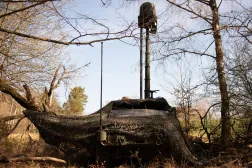Army taking new, modular approach to command posts

SAVANNAH, Ga. — The Army is going away from its old command post model and moving towards an umbrella approach that can be tailored by units and theater — a concept dubbed “configurable command and control.”
As the Army continues to modernize for large-scale combat operations — shifting away from the global war on terror against technologically inferior enemies in relatively confined spaces to competition with sophisticated nation-states that operate over vast distances — it’s looking for more survivable and modular capabilities.
Part of that effort is folding portfolios under the purview of what the Army is calling configurable C2, a guiding document that will help the government and industry understand the service’s needs. Rather than being very prescriptive, as similar documents have been in the past articulating the exact parameters that a certain capability must possess, this document is more capability-focused rather than zeroing in on specific technologies or specifications.
This is meant to allow commanders flexibility.
“What I find is that as I talk to commanders, that every division commander has a different vision for how they’re going to fight their division. Actually, I’ve talked to division commanders that commanded the same division at different points, and their vision for what a command post should look like was entirely different,” Maj. Gen. Patrick Ellis, director of the command and control cross-functional team, said in an interview at the Army’s Technical Exchange Meeting. “I don’t want to say it’s purely personality driven, but part of the approach is, let’s give commanders the building blocks for command and control and let them assemble them how they want, what makes sense to them, because their missions change, their personalities change, the task. They could go from one large combat here in the Pacific to Europe. It’s an entirely different fight.”
The Army has been trying to introduce more flexibility into systems, not outfitting everyone with the same gear given each unit fights differently and in a different part of the world, which is somewhat of a paradigm shift.
If the service needs to get more specific about its needs, there will be annexes in the configurable C2 document that can be added or subtracted over time.
Chief among the new or updated capabilities are command posts. The Army is doing away with its Command Post Integrated Infrastructure (CPI2), and looking for something more flexible and tailorable.
CPI2 was too focused on specific capabilities — initially the Family of Medium Tactical Vehicles variants, which are very large — and that was too rigid, according to officials.
“We are reimagining this program around modularity and options,” Mark Kitz, program executive officer for command, control, communications and networks, said in an interview, calling the new effort “modular command post.”
“Gen. Ellis is going to talk about how he’s reworking the requirement document to give me flexibility to go to commanders and give options around: If they’re an ISV unit, what are the options that they get? If they’re a Stryker unit, what are the options to get armor information on the move? What is your options in a Bradley, in an Abrams, in a Humvee, in a JLTV? You name the combat platform? Or what is the modular solution with 101st [Airborne Division]?”
The Army is thinking about configurable and modular command posts in many ways, to include power sources and survivability against a variety of threats.
“It’s not a new and novel technology, but it’s really important for how they configure their CPs and what batteries they’re carrying,” Kitz said. “I think survivability is another. I keep hitting this, how that CP is survivable, whether that’s in their network, whether that’s their EMS, whether that’s how they run security. Like, all of that is related into their command post. Having a generic document so that I can provide those technology options, I think, is absolutely key.”
The Army will keep working with units and gaining feedback to continue to make improvements as needed.
In the near term, the funds that were previously allocated for CPI2, which weren’t a lot, will be folded into the new effort and the Army will be working with Congress on how to reestablish the reimagined program.






